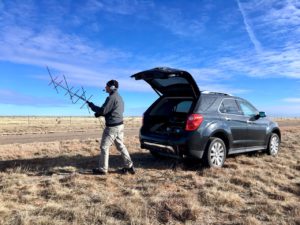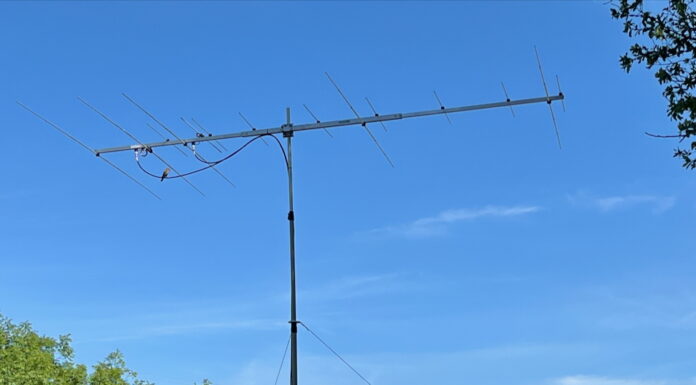The choice was reasonably simple. I was in Amarillo, DM95, visiting my daughter and son-in-law. Friday, while they were both at work, I got up at zero-dark-thirty and traveled about 2.5 hours to the grid line. I allowed 45 minutes to get everything set up and then worked FO-29, XW-2A, AO-85, and another FO-29 pass.
Grid Line Found
 Finding the grid line was relatively easy. You can see the nearby photo of the road and lots of shoulder for parking. Then I moved back and forth until I could be absolutely sure that I parked on the grid line. I took photos from the Maidenhead and MyGPS Coordinates apps on my phone for validation — all per the VUCC Rules.
Finding the grid line was relatively easy. You can see the nearby photo of the road and lots of shoulder for parking. Then I moved back and forth until I could be absolutely sure that I parked on the grid line. I took photos from the Maidenhead and MyGPS Coordinates apps on my phone for validation — all per the VUCC Rules.
Station Set Up
My roving set up is an Icom IC-910H, Arrow antenna, Apple MacBook Air with MacDoppler, an XG Comms USB connection to the rig, as well as a 35 amp hour sealed lead acid battery. I also use the AudioNote app on my laptop to record the QSOs. It’s not a lightweight set up — it’s more in line with my belt and suspenders approach to most things.
I also spent some time testing my portable system prior to the activation because I didn’t want to drive all that distance and then not get on the air. So I tested it all at home outside on the deck and then in Amarillo in my daughter’s backyard, providing a few contacts with DM95.
 Even with that testing, I still encountered a few problems on the grid line. The first was that the USB connector appeared to be physically broken. Fortunately, it was only the plastic case that was falling off. Electrically it worked just fine. Although, that wasn’t confirmed until I booted and rebooted the radio and laptop to get the connection working. That is the normal challenge connecting to macOS. It happens at home with my IC-9100 as well.
Even with that testing, I still encountered a few problems on the grid line. The first was that the USB connector appeared to be physically broken. Fortunately, it was only the plastic case that was falling off. Electrically it worked just fine. Although, that wasn’t confirmed until I booted and rebooted the radio and laptop to get the connection working. That is the normal challenge connecting to macOS. It happens at home with my IC-9100 as well.
Yet another problem was discovered after the first couple of passes. I was taking a few photos and realized that one of the UHF elements on the Arrow was missing. Didn’t seem to pose much of a problem on the air, fortunately. I later found the two arrows and the screw lying on the floor in the car. They had vibrated loose during the drive. Glad I found them and that it didn’t pose an on the air problem.
Results
I managed to get 22 stations in the log and many of them reported at least one new grid for their logs. Burt, FG8OJ, was the first caller right after my initial CQ on FO-29. He reported that it was at 1 degree elevation for him. He was waiting for me as he needed that grid. Only Christy, KB6LTY, answered my call on XW-2A. I had thought about skipping the FO-29 pass that was at 20 degrees and to the west. But when I got on I worked as many as on the first FO-29 pass. So that worked out well.
Thanks to everyone who got up early to work me. It’s really satisfying to provide new grids and do some small payback for the very active grid rovers that have filled up my logbook.
This article also appears in The AMSAT Journal, January/February 2018, Volume 41, Number 1, page 15.








